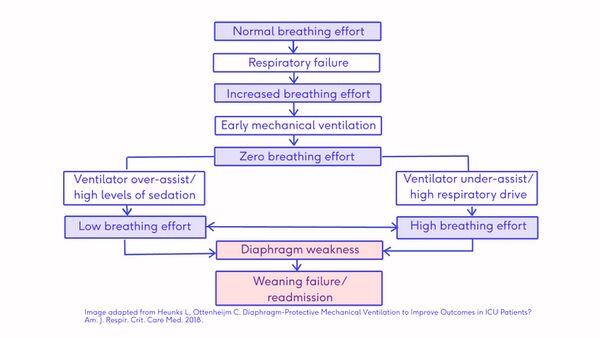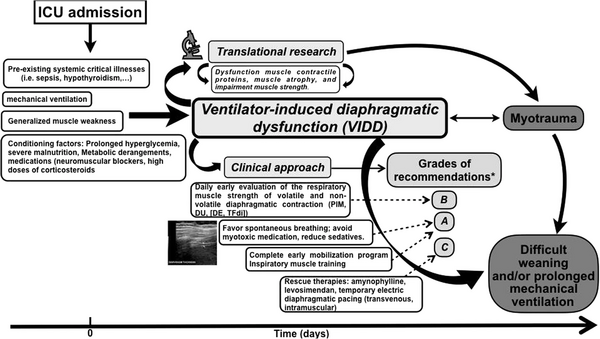Diaphragmatic Breathing and Ventilator-Induced Diaphragmatic Dysfunction: Difference between revisions
Carin Hunter (talk | contribs) No edit summary |
No edit summary |
||
| Line 3: | Line 3: | ||
== Effects of Diaphragmatic Breathing == | == Effects of Diaphragmatic Breathing == | ||
# '''Detoxifies and releases toxins:''' | # '''Detoxifies and releases toxins:'''<ref name=":1">Eugene, OR Website. Diaphragm Deep Breathing. Available from: https://www.eugene-or.gov/DocumentCenter/View/14142/Diaphagmatic_breathing?bidId= (accessed 2 December 2021). </ref> | ||
#* | #* The human body is able to release 70% of its toxins through breathing. It is recommended that diaphragmatic breathing at least 3 times per day for 39 seconds can be beneficial. | ||
# '''Anti-stress:'''<ref>Hunt MG, Rushton J, Shenberger E, Murayama S. [https://journals.humankinetics.com/view/journals/jcsp/12/1/article-p27.xml Positive effects of diaphragmatic breathing on physiological stress reactivity in varsity athletes.] Journal of Clinical Sport Psychology. 2018 Mar 1;12(1):27-38.</ref> | # '''Anti-stress:'''<ref name=":1" /><ref>Hunt MG, Rushton J, Shenberger E, Murayama S. [https://journals.humankinetics.com/view/journals/jcsp/12/1/article-p27.xml Positive effects of diaphragmatic breathing on physiological stress reactivity in varsity athletes.] Journal of Clinical Sport Psychology. 2018 Mar 1;12(1):27-38.</ref> | ||
#* When | #* When someone experiences stress, their brain releases cortisol (i.e. the "stress hormone"). Cortisol causes an increase in heart rate and blood pressure. | ||
#* | #* Taking a few diaphragmatic breaths can lead to a reduction in heart rate. This allows more oxygen to enter the bloodstream which calms the brain down (i.e. reduces anxiety, improves circulation, enhances muscular relaxation etc). | ||
#* Deep breathing can | #* Deep breathing can also lead to the release of endorphins, which elevates mood. | ||
# '''Relaxation and mood elevation:'''<ref>Hamasaki H. [https://www.mdpi.com/2305-6320/7/10/65 Effects of Diaphragmatic Breathing on Health: A Narrative Review.] Medicines. 2020 Oct;7(10):65.</ref> | # '''Relaxation and mood elevation:'''<ref name=":1" /><ref>Hamasaki H. [https://www.mdpi.com/2305-6320/7/10/65 Effects of Diaphragmatic Breathing on Health: A Narrative Review.] Medicines. 2020 Oct;7(10):65.</ref> | ||
#* Diaphragmatic breathing stimulates the vagus nerve which | #* Diaphragmatic breathing stimulates the vagus nerve which induces relaxation. NB 75% of vagal nerve fibres are parasympathetic. | ||
# ''' | # '''Pain relief:'''<ref name=":1" /><ref name=":2">Watkins A. Benefits of deep breathing [Internet]. Urban Balance. 2014 [cited 2 December 2021]. Available from: https://www.urbanbalance.com/benefits-deep-breathing/</ref> | ||
#* Breathing into pain | #* Breathing into pain can result in improved circulation to that specific area, relieve tension and enhance oxygenation levels. This triggers the release of endorphins, which has a positive impact on pain levels. | ||
# ''' | # '''Enhances the immune system:'''<ref name=":1" /> | ||
#* Deep breathing | #* Deep breathing improves an individual's ability to metabolise nutrients and vitamins. It is also beneficial for digestion, which ultimately strengthens immunity. | ||
# ''' | # '''Reduces blood pressure:'''<ref name=":2" /> | ||
#* | #* Relaxation leads to dilation of the blood, which improves circulation and decreases blood pressure. Deep breathing also helps to reduce / regular heart rate, which has a positive impact on blood pressure. | ||
# ''' | # '''Improves cellular regeneration:'''<ref name=":1" /> | ||
#* | #*[[Diaphragmatic Breathing Exercises|Deep breathing]] helps our bodies to be better oxygenated and improves circulation. This helps to improve cellular regeneration. | ||
# ''' | # '''Enhances posture:'''<ref name=":1" /><ref name=":2" /> | ||
#* Inspiration lengthens the spine, facilitates lumbopelvic movements, activates core muscles.<ref>Stephens RJ, Haas M, Moore III WL, Emmil JR, Sipress JA, Williams A. [https://www.sciencedirect.com/science/article/abs/pii/S016147541630166X Effects of diaphragmatic breathing patterns on balance: a preliminary clinical trial.] Journal of manipulative and physiological therapeutics. 2017 Mar 1;40(3):169-75.</ref> | #* Inspiration lengthens the spine, facilitates lumbopelvic movements, activates core muscles. It has also been shown that it may be associated with improvements in balance.<ref>Stephens RJ, Haas M, Moore III WL, Emmil JR, Sipress JA, Williams A. [https://www.sciencedirect.com/science/article/abs/pii/S016147541630166X Effects of diaphragmatic breathing patterns on balance: a preliminary clinical trial.] Journal of manipulative and physiological therapeutics. 2017 Mar 1;40(3):169-75.</ref> | ||
<div class="row"> | <div class="row"> | ||
| Line 29: | Line 29: | ||
== Evidence Based Practice == | == Evidence Based Practice == | ||
* Allison et al.<ref>Allison G, Kendle K, Roll S, Schupelius J, Scott Q, Panizza J. [https://www.sciencedirect.com/science/article/pii/S000495141460369X The role of the diaphragm during abdominal hollowing exercises.] Australian Journal of Physiotherapy. 1998 Jan 1;44(2):95-102.</ref> reported that | * Allison et al.<ref>Allison G, Kendle K, Roll S, Schupelius J, Scott Q, Panizza J. [https://www.sciencedirect.com/science/article/pii/S000495141460369X The role of the diaphragm during abdominal hollowing exercises.] Australian Journal of Physiotherapy. 1998 Jan 1;44(2):95-102.</ref> reported that diaphragmatic activity increases in healthy subjects during lumbopelvic motion control tests. | ||
* O’Sullivan and Beales<ref name=":0" /> concluded in their case studies that lumbopelvic movements decrease in patients with diaphragmatic injuries. | * O’Sullivan and Beales<ref name=":0" /> concluded in their case studies that lumbopelvic movements decrease in patients with diaphragmatic injuries. | ||
* Moreover, patients with chronic | * Moreover, patients with chronic low back pain have often been reported to have defects in posture and motor control.<ref name=":0">O’Sullivan P. [https://www.sciencedirect.com/science/article/abs/pii/S1356689X05001104 Diagnosis and classification of chronic low back pain disorders: maladaptive movement and motor control impairments as underlying mechanism.] Manual therapy. 2005 Nov 1;10(4):242-55.</ref><ref>Hodges PW, Moseley GL. [https://www.sciencedirect.com/science/article/abs/pii/S1050641103000427 Pain and motor control of the lumbopelvic region: effect and possible mechanisms]. Journal of electromyography and kinesiology. 2003 Aug 1;13(4):361-70.</ref> | ||
== Effect of Mechanical Ventilation on Diaphragm == | == Effect of Mechanical Ventilation on Diaphragm == | ||
Revision as of 21:52, 1 December 2021
Top Contributors - Ewa Jaraczewska, Carin Hunter, Jess Bell, Kim Jackson and Wanda van Niekerk
Effects of Diaphragmatic Breathing[edit | edit source]
- Detoxifies and releases toxins:[1]
- The human body is able to release 70% of its toxins through breathing. It is recommended that diaphragmatic breathing at least 3 times per day for 39 seconds can be beneficial.
- Anti-stress:[1][2]
- When someone experiences stress, their brain releases cortisol (i.e. the "stress hormone"). Cortisol causes an increase in heart rate and blood pressure.
- Taking a few diaphragmatic breaths can lead to a reduction in heart rate. This allows more oxygen to enter the bloodstream which calms the brain down (i.e. reduces anxiety, improves circulation, enhances muscular relaxation etc).
- Deep breathing can also lead to the release of endorphins, which elevates mood.
- Relaxation and mood elevation:[1][3]
- Diaphragmatic breathing stimulates the vagus nerve which induces relaxation. NB 75% of vagal nerve fibres are parasympathetic.
- Pain relief:[1][4]
- Breathing into pain can result in improved circulation to that specific area, relieve tension and enhance oxygenation levels. This triggers the release of endorphins, which has a positive impact on pain levels.
- Enhances the immune system:[1]
- Deep breathing improves an individual's ability to metabolise nutrients and vitamins. It is also beneficial for digestion, which ultimately strengthens immunity.
- Reduces blood pressure:[4]
- Relaxation leads to dilation of the blood, which improves circulation and decreases blood pressure. Deep breathing also helps to reduce / regular heart rate, which has a positive impact on blood pressure.
- Improves cellular regeneration:[1]
- Deep breathing helps our bodies to be better oxygenated and improves circulation. This helps to improve cellular regeneration.
- Enhances posture:[1][4]
- Inspiration lengthens the spine, facilitates lumbopelvic movements, activates core muscles. It has also been shown that it may be associated with improvements in balance.[5]
Evidence Based Practice[edit | edit source]
- Allison et al.[9] reported that diaphragmatic activity increases in healthy subjects during lumbopelvic motion control tests.
- O’Sullivan and Beales[10] concluded in their case studies that lumbopelvic movements decrease in patients with diaphragmatic injuries.
- Moreover, patients with chronic low back pain have often been reported to have defects in posture and motor control.[10][11]
Effect of Mechanical Ventilation on Diaphragm[edit | edit source]
- Ventilator-induced diaphragmatic dysfunction(VIDD):
- Loss of diaphragmatic force-generating capacity as a consequence to use of mechanical ventilation due to suppressed inspiratory effort.[12][13]
- Mechanical ventilatory assistance contributes to diaphragm muscle inactivity and unloading thus leading to diaphragmatic atrophy and fatigue.[14]
- Diaphragm weakness is a leading cause of difficult weaning from mechanical ventilation[15] and loss of thickness of diaphragm muscle, however, if there is insufficient ventilatory support and the diaphragm is not unloaded adequately this can lead to load-induced inflammation and injury.[16]
- Diaphragm atrophy developing during mechanical ventilation strongly impacts clinical outcomes. Targeting an inspiratory effort level similar to that of healthy subjects at rest might accelerate liberation from ventilation.[17]
 Ventilator-Induced Diaphragmatic Dysfunction Flow chart [18]
Ventilator-Induced Diaphragmatic Dysfunction Flow chart [18]

References[edit | edit source]
- ↑ 1.0 1.1 1.2 1.3 1.4 1.5 1.6 Eugene, OR Website. Diaphragm Deep Breathing. Available from: https://www.eugene-or.gov/DocumentCenter/View/14142/Diaphagmatic_breathing?bidId= (accessed 2 December 2021).
- ↑ Hunt MG, Rushton J, Shenberger E, Murayama S. Positive effects of diaphragmatic breathing on physiological stress reactivity in varsity athletes. Journal of Clinical Sport Psychology. 2018 Mar 1;12(1):27-38.
- ↑ Hamasaki H. Effects of Diaphragmatic Breathing on Health: A Narrative Review. Medicines. 2020 Oct;7(10):65.
- ↑ 4.0 4.1 4.2 Watkins A. Benefits of deep breathing [Internet]. Urban Balance. 2014 [cited 2 December 2021]. Available from: https://www.urbanbalance.com/benefits-deep-breathing/
- ↑ Stephens RJ, Haas M, Moore III WL, Emmil JR, Sipress JA, Williams A. Effects of diaphragmatic breathing patterns on balance: a preliminary clinical trial. Journal of manipulative and physiological therapeutics. 2017 Mar 1;40(3):169-75.
- ↑ Harvard Vanguard Medical Associates. Diaphragmatic Breathing Part 1 of 3 - Intro to Diaphragmatic Breathing Available from: https://www.youtube.com/watch?v=gAkjx25o4eI&t=3s [last accessed 10 November 2021]
- ↑ Harvard Vanguard Medical Associates. Diaphragmatic Breathing Part 2 of 3 - Breathing While Lying Down. Available from: https://www.youtube.com/watch?v=BckGYBfN5e0&t=64s [last accessed 10 November 2021]
- ↑ Harvard Vanguard Medical Associates. Diaphragmatic Breathing Part 3 of 3 - Seated or Upright Position. Available from: https://www.youtube.com/watch?v=1vXlTkrNxyw&t=18s [last accessed 10 November 2021]
- ↑ Allison G, Kendle K, Roll S, Schupelius J, Scott Q, Panizza J. The role of the diaphragm during abdominal hollowing exercises. Australian Journal of Physiotherapy. 1998 Jan 1;44(2):95-102.
- ↑ 10.0 10.1 O’Sullivan P. Diagnosis and classification of chronic low back pain disorders: maladaptive movement and motor control impairments as underlying mechanism. Manual therapy. 2005 Nov 1;10(4):242-55.
- ↑ Hodges PW, Moseley GL. Pain and motor control of the lumbopelvic region: effect and possible mechanisms. Journal of electromyography and kinesiology. 2003 Aug 1;13(4):361-70.
- ↑ Kim WY, Lim CM. Ventilator-induced diaphragmatic dysfunction: diagnosis and role of pharmacological agents. Respiratory care. 2017 Nov 1;62(11):1485-91.
- ↑ Peñuelas O, Keough E, López-Rodríguez L, Carriedo D, Gonçalves G, Barreiro E, Lorente JÁ. Ventilator-induced diaphragm dysfunction: translational mechanisms lead to therapeutical alternatives in the critically ill. Intensive care medicine experimental. 2019 Jul;7(1):1-25.
- ↑ Vassilakopoulos T, Petrof BJ. Ventilator-induced diaphragmatic dysfunction. American journal of respiratory and critical care medicine. 2004 Feb 1;169(3):336-41.
- ↑ Dres M, Dubé BP, Mayaux J, Delemazure J, Reuter D, Brochard L, Similowski T, Demoule A. Coexistence and impact of limb muscle and diaphragm weakness at the time of liberation from mechanical ventilation in medical intensive care unit patients. American journal of respiratory and critical care medicine. 2017 Jan 1;195(1):57-66.
- ↑ Orozco-Levi M, Lloreta J, Minguella J, Serrano S, Broquetas JM, Gea J. Injury of the human diaphragm associated with exertion and chronic obstructive pulmonary disease. American journal of respiratory and critical care medicine. 2001 Nov 1;164(9):1734-9.
- ↑ Lipson DA, Barnacle H, Birk R, Brealey N, Locantore N, Lomas DA, Ludwig-Sengpiel A, Mohindra R, Tabberer M, Zhu CQ, Pascoe SJ. FULFIL trial: once-daily triple therapy for patients with chronic obstructive pulmonary disease. American journal of respiratory and critical care medicine. 2017 Aug 15;196(4):438-46.
- ↑ Schepens T, Dres M, Heunks L, Goligher EC. Diaphragm-protective mechanical ventilation. Current opinion in critical care. 2019 Feb 1;25(1):77-85.






